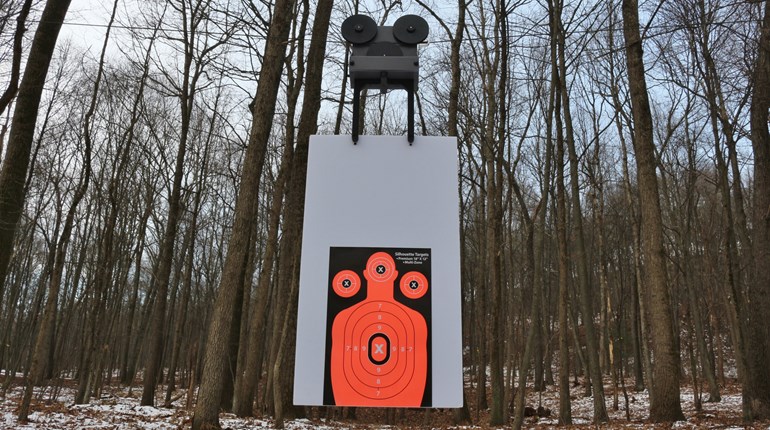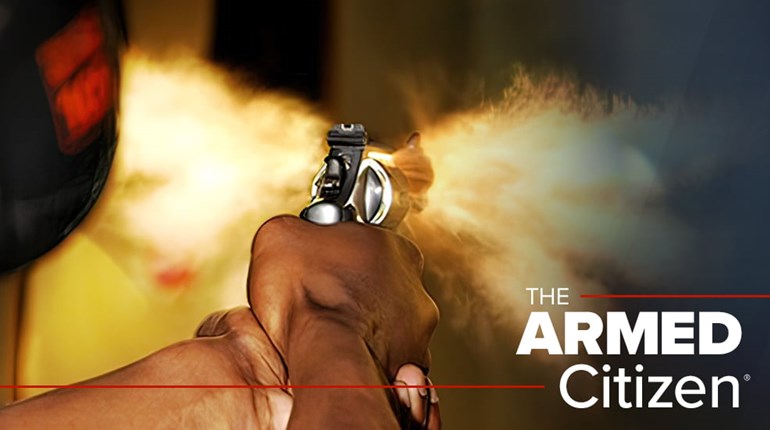
We’ve been on a technique “tear” lately (here and here), but with a purpose: Both in our teaching and competition venues, most difficulties in good handgunning performance just seem complex. Scrubbed of disguises, the inability to get the accuracy, speed or reliability we want—or for defensive purposes, need—is rarely overwhelming. And it’s certainly true that identical adjustments can’t always be the answer for all individuals.
This, in turn, leads us to our last difficult hand position (for now, at least), though perhaps the notion itself requires amendment. This technique makes our cut because of the difficulties it spares. A second key element commends it, too: It doesn’t depend on “A”-list athletic prowess/strength, or any physical attribute or aptitude, yet can be learned and practiced to a useful level in a hurry. This technique makes our cut because of the difficulties it spares.
Best, it gets back to Carry Life considerations at their core: If you can’t avoid through situational awareness, if you can’t retreat, what comes next must be decisive, both in terms of speed and precision.
Some will recognize this as a subset of the CAR shooting technique developed by Englishman Paul Castle. Castle died in 2011, but not before widely propagating this excellent, versatile technique. He developed it during many years as a member of British law enforcement, and built out the method upon his retirement and move to the United States. He became a highly sought-after trainer in many, shall we say “lofty,” shooting circles.
CAR stands for Center Axis Relock. There are many nuances here, but the most important is embodied in the idea that aiming and shooting (if necessary) should be centered on and (re)locked to the vertical axis of your body. The immediate result is good mobility (because body mass stays over the feet), superb balance (because the limbs are not extended) and extremely natural aiming: Because of gun position—which we’ll get to in a minute—optical accommodation to the sights is very much like reading in terms of distance, and strongly supplemented by body mechanics that are in essence “borrowed.”
We’ve stressed the importance of such borrowed efficiencies or aptitudes in the past and re-assert them now: CAR technique rightly recognizes the central axis as another opportunity for sub- or semi-conscious muscular action to very speedily supplement actual aiming and/or sighting of a firearm. CAR includes four possible positions for the firearm, but our interest is mainly the start: “High CAR,” and the subsequent “Extended CAR.”
High CAR puts both hands on the pistol at the center of the chest following the draw. The strong/master side grips as always, but the weak/support hand rotates clockwise for righties and counterclockwise for lefties about 90 degrees. The palm of the support hand essentially covers the fingers of the master hand at the front of the grip. No attempt is made to turn the firearm outward at the wrist. Enhanced CAR has many other advantages, but the likely best from a Carry Life standpoint is the precision it offers to shots made while moving.
This points the muzzle strongly left for the right-handed shooter (again, the reverse for lefties), and as a consequence, CAR doctrine “blades” (rotating the center axis) to bring the pistol to bear on the threat. Simply move the weak side foot well forward to bring the muzzle around. Wrists are straight, and elbows flexed, with both essentially locked at this point by muscle tension.
An important observation here, and one of the reasons the whole body of Castle’s technique appeals: You can shoot from right here if you must. With both hands on the firearm, recoil control (and subsequent functioning) are likely assured; the locking of the wrists and elbows feeds cycling energy rapidly and efficiently back into the pistol. Accuracy at defensive ranges is an apparent side effect of the pistol being at the body’s centerline/axis, but of course, isn’t. Rather, it’s the megaphoned manifestation of the soundness of Castle’s underlying theory.
Some representations of the position at this point extend the elbows more than we think is necessary. This is by no means wrong, and very much as Castle taught High CAR. Our “objection,” mild as it is, stems from a pair of considerations: The amplitude of the movement to get there is larger than necessary—it “telegraphs” more about what you’re doing to an external observer—and it doesn’t add to the shot precision or functional reliability coefficients, as far as we can tell.
We believe that drawing the elbows in is slightly better for retention (always a strong suit of CAR) and indoor maneuverability, but also an aid to accuracy: it places the centered axis pistol somewhat higher on the chest, and closer to the (eye) sight line. By reducing “parallax,” the offset between the sight line and the bore line, it seems to slightly enhance the precision of this “point” technique shot.
From High CAR, Extended CAR is a rapid movement of the sights up to the eye line and slightly out toward the threat. Much as we laud High CAR, this is where Castle’s genius really shines: The crucial front sight is now at that “reading distance” accommodation we referred to, and astonishingly accurate shots at surprising speed are possible. How far forward? We think 18 inches is the practical/necessary maximum, and we, despite being slightly monkey-armed, are much closer: About 13 inches (bridge of the nose to front sight).
A lot of “uh-ohs” reverberate at the range when we get to a demonstration of this, but proper execution fades them just as quickly. The most common is the most obvious: “Isn’t that awfully close to your face?!?”
Well, yes. But here we get to another misunderstanding about all the CAR positions: Some seasoned observers have opined, with more than a hint of triumph, that it’s the re-emergence of “push-pull” as a recoil control technique. Aaaaaah, nope. This has quite literally massive implications for “getting off the X.”
Instead, it’s those locked wrists but flexed elbows that create the vital dynamic tension that controls the pistol, and in the same large groups of muscles they always should. Not just in the arms and hands (as push-pull does), but across chest and back, tensed muscles and bent elbows allow a mode of recoil dissipation that skeletal absorption can rarely match, especially in terms of returning the firearm quickly to an “index,” shot-ready position. Granted, CAR geometry is different: The strong side elbow cants outward/upward away from the torso to eliminate twist in the wrist (the natural “pointing” angle we discuss here is generally strongest and most dissipative), and the “V” of the weak side elbow points straight down.
In practice, the tension in this grip method doesn’t let the rear of that reciprocating slide near your face. We understand if you’re still apprehensive, so push the gun out far enough to seem absolutely safe to you when you begin to practice, and work inwards as your experience dictates. With the pistol pushed out, you’ll actually be in a push-pull configuration, but this is useful too—you’ll feel the transition to the correct dynamics as you draw the pistol back. We’ve yet to see anybody stay “out there.” Castle was simply correct about this crucial aspect of the geometry and mechanics as it relates to recoil control: It works just as he asserted, and obviously better than push-pull.
Enhanced CAR has many other advantages, but the likely best from a Carry Life standpoint is the precision it offers to shots made while moving. Because the pistol is close to the body, there is no long “lever” of the extended arms on which the pistol can unhelpfully bounce as we stride. Unwanted horizontal movement is damped in its turn by another mechanical advantage: Recoil energy falls by design along the body’s center axis, and can’t exert misaligning vectors sufficiently powerful to overcome the built-in, corrective dynamic tension.
This has quite literally massive implications for “getting off the X,” that is, forcing an aggressor to change their plan, hopefully to the point of abandonment. Because these acquisitive gambits are often as much about dominance as “stuff,” two intermediate states between “fight” and “flight” are likely to be encountered. The first is “flight with abandonment,” wherein you drop whatever you think will be more interesting or useful than the fruits of a confrontation, and beat feet. It’s hard on the ego to be sure, but (likely) much easier on the wallet than lawyers or doctors. Or both. Do it, if you can.
The dominance need of some criminals makes this tough, however; for many, it’s no longer sufficient to coerce the surrender of your property. More explicit submission is the price of survival, and often where things get badly out of hand. You won’t need lawyers if you’re lucky, but will need doctors if you’re not; maybe many doctors, and with advancing age the likelihood you’ll never really recover is starkly real. “They” are that mean, that unmerciful, that undaunted by laws and other distant consequences.
It’s here that the fourth circumstance, that of a “covered retreat,” comes into play: Abandon your stuff, but withdraw in a fashion that makes pursuit uninviting. Now the aggressor must choose: He has your stuff, but is also looking down the barrel of your defensive firearm as you retreat. You can never know until it happens what their decision will be, but … you get the idea. “They” are that mean, that unmerciful, that undaunted by laws and other distant consequences.
Extended CAR makes such a scenario possible. While advancing in CAR is a huge and obvious strong suit, it’s in retreat that its advantages proliferate. For a righty, retreat to the right allows you to look over your sights in Extended CAR, yet keep your toes pointed in the direction of travel and safety, while dramatically reducing the likelihood of a dangerous fall onto the back of the head. If cover or safety are to your left, simply “skin” to the other hand: You should have discovered in your practice that no weak side grip option comes along as quickly as Extended CAR.
As with any new technique, we strongly suggest qualified training, and lots of “dry” practice. That said, three cautions deserve attention. The first is a general range safety issue: When you’re in High CAR, don’t lose sight of the “blading” requirement. You’re only a few degrees from having a muzzle up-range on the weak side if you forget this. When your range mates get a little hacked, well, no surprise. Trigger discipline to the rescue, right?
Blading has issues too. A very serious bunch of practitioners don’t willingly “blade” because it exposes the armhole of any body armor to penetration. Castle’s view was that the weak side arm was over this opening, and provided some protection—a small tradeoff for the other efficacies of CAR. Critics observe that it’s not merely scanty, but sacrificial. Hmmmmmmm.
The last relates to your draw: Because getting into High CAR ends close to the body, it’s important to join the hands without sweeping yourself. Last week’s elbow up/elbow down will work fine, as will a more conventional beginning, as long as the “timing” position for the weak hand is observed. Let the muzzle of your pistol get out in front before you join the hands. Our suggestion about a somewhat higher High CAR helps here: The weak hand has more opportunity to join from the bottom up.
Now CAR and Carry On.


































